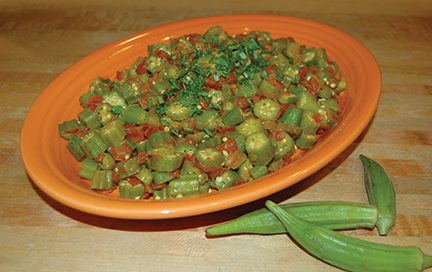 Vegetarians seeking flavorful variations can turn to 9,000 Indian, Pakistani and Bangladeshi grocery stores nationwide.
Vegetarians seeking flavorful variations can turn to 9,000 Indian, Pakistani and Bangladeshi grocery stores nationwide.
“We are now seeing 20 percent non-Indian customers in our store,” says Vipul Patel, owner of the Louisville, Kentucky, branch of Patel Brothers, the largest Indian U.S. grocery store chain. “Usually, new customers come in with an Indian recipe and we help them find the ingredients.”
“We are now seeing 20 percent non-Indian customers in our store,” says Vipul Patel, owner of the Louisville, Kentucky, branch of Patel Brothers, the largest Indian U.S. grocery store chain. “Usually, new customers come in with an Indian recipe and we help them find the ingredients.”
Indian Veggies
Vegetarianism has been a way of life in India for millennia. Some Indian vegetables may already seem familiar; winter melon, or white pumpkin, for example, is a squash that cooks and tastes like its orange counterpart. Eggplants native to India are egg-shaped and smaller than the American variety; they cook in less time and have a less bitter taste.
Other popular Indian vegetables, such as okra seedpods (eaten as a curried entrée or side dish and also used to thicken stews and soups), fenugreek leaves and aromatic seeds from the pea family have become common American crops. Tindura, a gourd used in curry, and daikon, often eaten raw in salads or seasoned as stuffing in flatbread, are relatively new here.
“By eating a larger variety of vegetables, consumers benefit from an increased array of vital nutrients and specialized phytochemicals that have healing and medicinal qualities,” says Ronald Hubbs, a practitioner at NW Naturopathic Medicine, in Portland, Oregon. He advises against overcooking vegetables to maintain their nutritional qualities.
Hubbs notes that bitter gourd is probably one of the most underappreciated Western foods, yet studies on mice sponsored by the Garvan Institute of Medical Research, in Sydney, Australia, and the Chinese government show that it contains four compounds that are effective in reducing blood glucose levels in diabetic patients.
Also consider pickled vegetables, known as achar. “Naturally fermenting vegetables can turn some of them into superfoods, with enhanced properties that are rich in healthy bacteria and support digestion and immunity,” says Hubbs, citing studies in the Journal of Nutrition and Clinical Microbiology Reviews.
Daals, or lentils, including Indian diet staples peas and beans, provide a good source of protein that is also high in fiber, he says. Lentils—highly versatile and available with or without the skin, whole or split—can be eaten thick and creamy, soup-like or dry, cooked with other vegetables or simply enhanced with basic Indian spices. Popular legumes include black-eyed peas and garbanzo beans. Different regions in the Indian subcontinent have their preferred daal spices and cooking methods, but all citizens often serve them with boiled rice or Indian bread, called chapatti.
Indian Spices
Although often considered “hot”, the blend of aromatic herbs and spices used in many Indian dishes, including those incorporating dairy, can be layered in for tantalizing flavors without necessitating frequent water breaks.
Many commonly used herbs and spices have proven medicinal properties, historically recognized for their healing properties in ayurvedic therapies and more recently, in Indian alternative medicine. According to University of Illinois research, fennel flower (black seed) and fenugreek improve lactation. University of Maryland Medical Center research shows that fennel seeds aid digestion. Further, the Journal of Phytopathology reports that carom seeds have antiseptic properties.
Recently, researchers at Penn State University found that antioxidant spices such as turmeric, oregano, cinnamon, cloves and paprika reduced triglycerides in the blood by 30 percent, helping to reduce the risk of chronic disease. “That’s because adding spices to a meal decreases the amount of fat in the bloodstream after eating,” explains study leader Ann Skulas-Ray, Ph.D. “There are clear benefits to adding spices to your meal, even if you’re only adding them occasionally.”
Sprinkling a little turmeric and ginger on legumes or other vegetables while boiling or sautéing them can create a palate-pleasing dish with health benefits. Numerous studies, including those from the University of Michigan and the University of Minnesota, show that these ingredients may help fight several kinds of cancer, reduce inflammation and relieve arthritis pain, among other benefits.
Americans can easily learn to bring out the best in their own Indian cuisine with the subcontinent’s alluring blends of herbs and spices delivering both unforgettable flavor and nutrient-rich fare.
Bushra Bajwa is a freelance writer in Issaquah, WA. Connect at [email protected].





